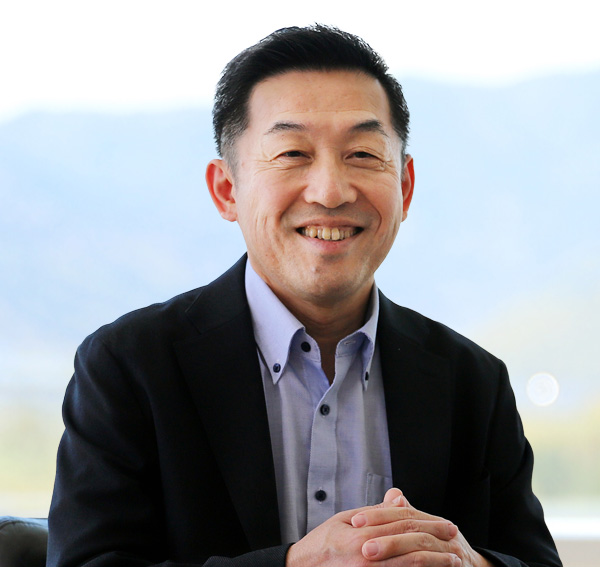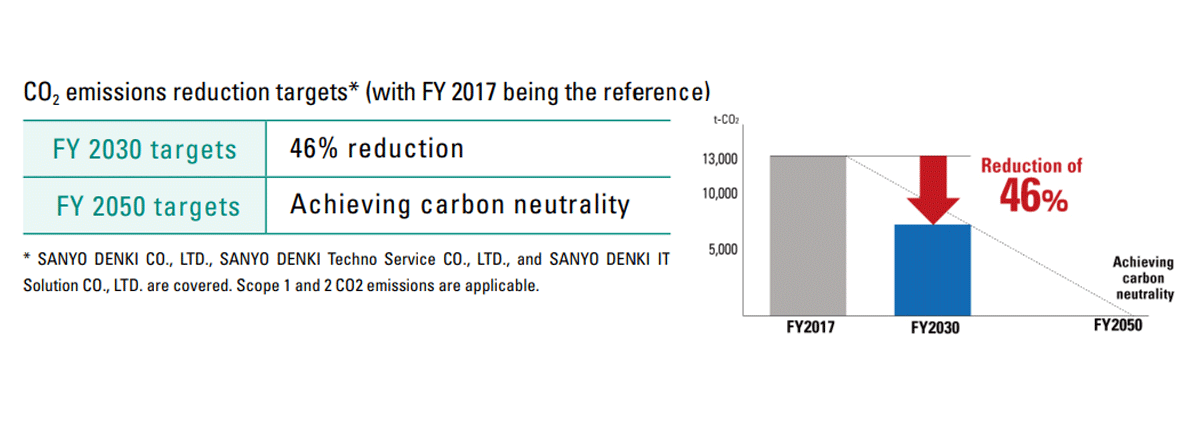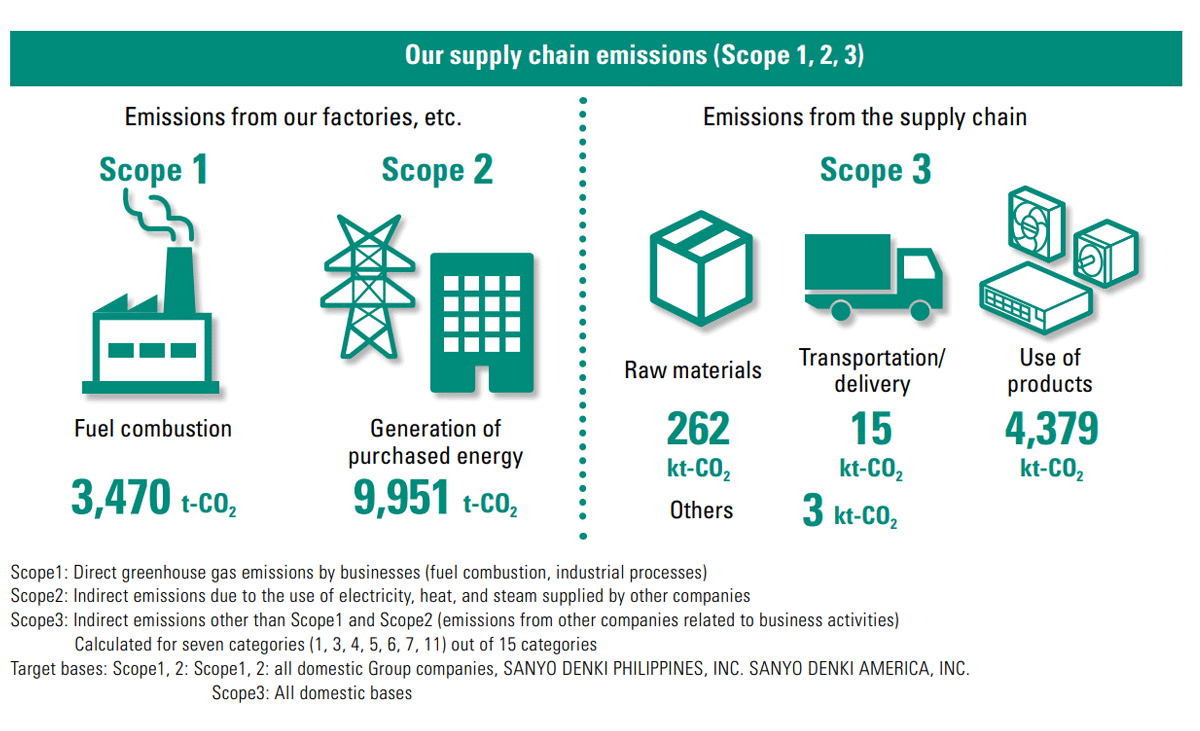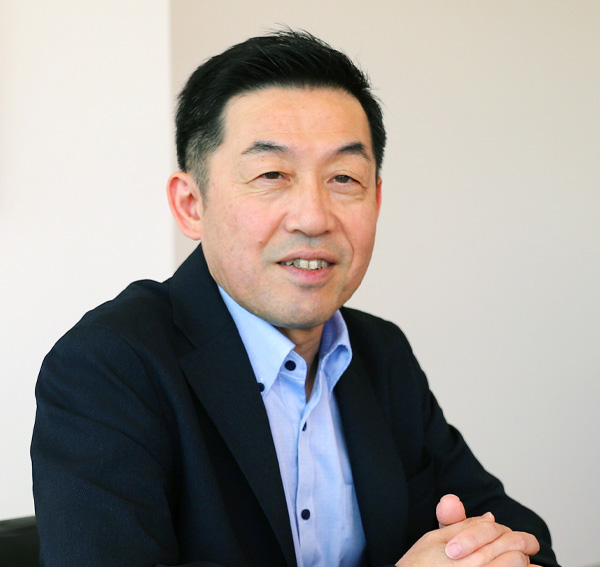



-
- Free Word Search




In recent years, as awareness of environmental issues has increased, keywords such as "carbon neutral" and "reducing environmental impact" have been attracting attention both inside and outside the company.
So why is environmental stewardship so important now? And how is SANYO DENKI contributing to reducing the environmental impact through its products?
We spoke with Miyahara Akio, head of the Environmental Technology Promotion Department, who is at the forefront of this effort, about the background to the initiative, specific measures being taken, and outlook for the future.

▲Akio Miyahara, Manager, Environmental Technology Promotion Department
We consider the prevention of global warming and the reduction of climate change risks to be the top priority of our corporate activities. To promote these goals, it is essential to achieve carbon neutrality. Therefore, in order to take a proactive approach, we have set targets for reducing CO2 emissions and are promoting carbon neutrality. In March 2023, we announced our medium- to long-term goals for reducing CO2 emissions. Our goal is to reduce CO2 emissions by 46% in fiscal 2030 compared to fiscal 2017, and to achieve carbon neutrality in fiscal 2050.

▲Akio Miyahara, Manager, Environmental Technology Promotion Department
▼Medium- to long-term goals for reducing CO2 emissions

Our CO2 emissions are calculated based on the global greenhouse gas protocol "Scope". In fiscal 2023, Scope 1 (direct emissions from our own fuel combustion) and Scope 2 (indirect emissions from electricity use) emissions accounted for less than 1% of the total, while Scope 3 (the entire supply chain) emissions from "product use" accounted for 94%. Therefore, we believe that reducing CO2 emissions from factory operations through energy conservation and energy creation efforts, as well as reducing emissions from "product use", is the key to promoting carbon neutrality. In order to reduce emissions from "product use", it is essential to reduce the power consumption of products. Therefore, we are promoting "environmentally friendly design" that reduces environmental impact from the product design stage, and are working to reduce power consumption and CO2 emissions.
▼CO2 emissions by Scope for FY2023


"Environmentally Friendly Design" is an approach that takes into consideration the impact on the environment and incorporates pollution prevention, resource conservation, energy conservation, and improved recyclability into the design. In particular, we place emphasis on energy conservation performance and evaluate the impact on the environment through life cycle assessment (LCA). Design engineers consider reducing the environmental impact from the development stage and evaluate the effect through product assessment.

▼Considerations and guidelines for environmentally friendly design
| Evaluation items | Environmental impact reduction effect | |
|---|---|---|
| 1 | Weight reduction (smaller size and lighter weight) | Resource conservation and global warming |
| 2 | Longer life | Resource conservation and global warming |
| 3 | Safety and environmental friendliness | Chemical substance management, safety and health |
| 4 | Recycling | Resource conservation and recycling |
| 5 | Product degradability | Resource conservation and recycling |
| 6 | Disposal | Chemical Substance Management |
| 7 | Collection and transportation | global warming |
| 8 | Disclosure of Information | Resource conservation and recycling |
| 9 | Energy Conservation | global warming |
| 10 | LCA (CO2 emissions) | global warming |
▼Eco Products and Eco Products Plus symbols and logos

"Eco Products" are products with a low environmental impact developed based on environmentally friendly design. We compare existing products and products on the market with 10 evaluation criteria and certify products that meet the criteria as "Eco Products". Furthermore, we will review the certification criteria in fiscal 2023 and set products that have a greater environmental impact reduction effect than "Eco Products" as "Eco Products Plus". We believe that by developing these "Eco Products" and having our customers use them, we can contribute to reducing CO2 emissions not only from our company but also from our customers' equipment. Furthermore, we are preparing a new indicator called "environmental contribution amount" to quantitatively present to customers the effect of reducing CO2 emissions when using our products.
▼Eco Products and Eco Products Plus symbols and logos


A5. As mentioned above, we consider the achievement of carbon neutrality to be a social issue. Therefore, we are strengthening the connection with our regular work so that each employee can take it personally. In addition to reducing CO2 emissions from electricity and fuel use in production activities, we will contribute to reducing CO2 emissions worldwide by developing, expanding our lineup, and promoting sales of "eco products."

We now live in an age where consideration for the environment is an essential part of a company's responsibility.
SANYO DENKI 's "Eco Products" are not just environmentally friendly products, but powerful solutions that can contribute to reducing CO2 emissions from our customers' entire equipment.
We hope that this interview will help you understand the background and significance of these products, and we will continue to actively promote our "eco products" and work with as many customers as possible to help realize a sustainable society.
Published date: 2025-04-28 16:18